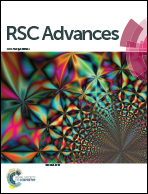PdPt bimetallic alloy nanowires-based electrochemical sensor for sensitive detection of ascorbic acid†
Abstract
One-dimensional (1D) bimetallic nanowire materials have attracted much more attention in electroanalysis because of their unique physical and chemical properties. In this work, we further extended the application field of the PdPt bimetallic alloy nanowires (PdPt BANWs) structure and successfully fabricated a novel PdPt BANWs-based electrochemical sensor for sensitive detection of ascorbic acid (AA). It was found that the PdPt BANWs on the electrode exhibited remarkable electrocatalytic activity toward AA oxidation and could be used for sensitive detection of AA in a wide linear range (0.01–0.97 mM) with a high sensitivity of 467.9 μA mM−1 cm−2. The detection limit is as lower as 0.2 μM (S/N = 3). Moreover, the electrochemical sensor also exhibited good selectivity, reproducibility and stability, and had been successfully applied to detection of AA in serum samples and commercial vitamin C tablets with satisfactory results.


 Please wait while we load your content...
Please wait while we load your content...